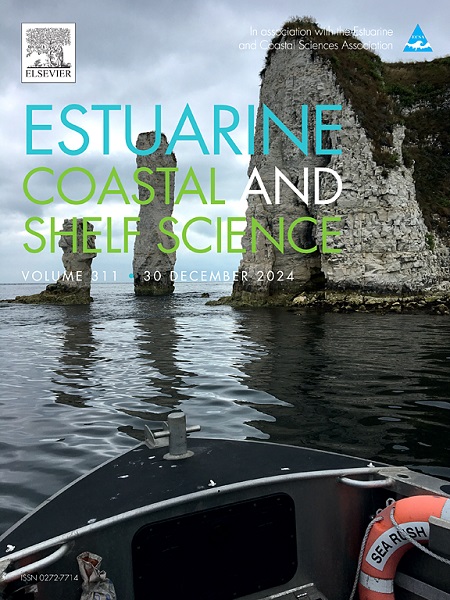Classification of exposed sediments in the Great Bay Estuary using C-band synthetic aperture radar
IF 2.6
3区 地球科学
Q1 MARINE & FRESHWATER BIOLOGY
引用次数: 0
Abstract
Estuarine tidal flats represent critical coastal environments but are often challenging to characterize due to their soft nature and challenges associated with site access. To address this gap, this study investigates the use of satellite-based remote sensing for this application. Towards this goal, the trends in backscatter response from the C-band Sentinel-1 satellite for three distinct tidal flats (two fine-grained, one predominately coarse) on the Great Bay Estuary in southeastern New Hampshire and southern Maine in the United States were analyzed for a 3.5-year period from August 2020 until December 2023. The three sites were composed of unique classification following the Unified Soil Classification System (USCS): an elastic silt (Woody), low-plasticity silt (Adams Point), and a site composed of spatially varying sandy classifications (Mast Cove). Four statistical properties of the histograms of backscatter that compose the three tidal flats (mean backscatter, standard deviation, uniformity, and entropy) were analyzed. Of these, mean backscatter proved to be the best for distinguishing between sites composed of different soil types, with higher backscatter (−13.3 dB to −14.6 dB) used to distinguish between sands and fine-grained soils, while lower backscatters (−17.2 dB to −18.1 dB) were used to differentiate between Adams Point and Woody. Seventeen mean backscatter values resulted in classifications that differed from the anticipated trends, and environmental factors such as rainfall, wind, or ice formation that may impact the flat are discussed.
利用c波段合成孔径雷达对大海湾河口暴露沉积物进行分类
河口滩涂是重要的海岸环境,但由于其松软的特性以及与进入现场相关的挑战,要描述其特征往往具有挑战性。为了弥补这一不足,本研究对卫星遥感在这一领域的应用进行了调查。为实现这一目标,研究人员对美国新罕布什尔州东南部和缅因州南部大湾河口三个不同滩涂(两个细粒度,一个以粗粒度为主)的 C 波段哨兵-1 卫星反向散射响应趋势进行了分析,分析时间为 2020 年 8 月至 2023 年 12 月,为期 3.5 年。这三个地点按照统一土壤分类系统(USCS)进行了独特的分类:弹性粉土(伍迪)、低弹性粉土(亚当斯角)以及由空间变化的沙土分类组成的地点(马斯特湾)。对构成这三个滩涂的后向散射直方图的四个统计特性(平均后向散射、标准偏差、均匀性和熵值)进行了分析。其中,平均后向散射被证明是区分不同土壤类型的最佳方法,较高的后向散射(-13.3 dB 至-14.6 dB)用于区分沙土和细粒土,而较低的后向散射(-17.2 dB 至-18.1 dB)用于区分亚当斯角和伍迪。有 17 个平均反向散射值的分类结果与预期趋势不同,对可能影响平地的降雨、风或结冰等环境因素进行了讨论。
本文章由计算机程序翻译,如有差异,请以英文原文为准。
求助全文
约1分钟内获得全文
求助全文
来源期刊
CiteScore
5.60
自引率
7.10%
发文量
374
审稿时长
9 months
期刊介绍:
Estuarine, Coastal and Shelf Science is an international multidisciplinary journal devoted to the analysis of saline water phenomena ranging from the outer edge of the continental shelf to the upper limits of the tidal zone. The journal provides a unique forum, unifying the multidisciplinary approaches to the study of the oceanography of estuaries, coastal zones, and continental shelf seas. It features original research papers, review papers and short communications treating such disciplines as zoology, botany, geology, sedimentology, physical oceanography.

 求助内容:
求助内容: 应助结果提醒方式:
应助结果提醒方式:


